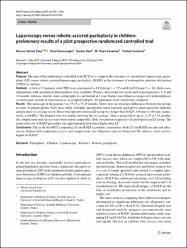Laparoscopy versus robotic-assisted pyeloplasty in children: preliminary results of a pilot prospective randomized controlled trial
Özet
Purpose The aim of this randomized controlled trial (RCT) is to compare the outcomes of conventional laparoscopic pyeloplasty (LP) versus robotic-assisted laparoscopic pyeloplasty (RALP) in the treatment of ureteropelvic junction obstruction (UPJO) in children. Methods A total of 53 patients with UPJO were randomized as LP (Group 1,n: 27) and RALP (Group 2,n: 26). Redo cases and patients with anatomical abnormalities were excluded. Urinary ultrasound was performed at postoperative 3, 6 and 12 months; whereas, diuretic renal scintigraphy was performed at 1 year. Failure was defined as progressive hydronephrosis on ultrasound, decline in renal function, or symptom relapse. All parameters were statistically compared. Results The mean age of the patients was 55.53 +/- 57.25 months. There were no statistical differences between the groups in terms of patient gender, body mass index, laterality, preoperative renal function, renal pelvis antero-posterior diameter and presence of crossing vessel. Mean total operative time in LP group was longer than RALP (139 min vs 105 min, respectively,p = 0.001). The hospital stay was similar between the two groups. After a mean follow-up of 12.43 +/- 5.34 months, the complication and success rates were found comparable. Only two patients required re-do pyeloplasty in LP group. The mean total cost of RALP procedure was approximately four times higher than LP. Conclusions This is the first RCT comparing LP and RALP in pediatric population. Both LP and RALP are safe and effective in children with comparable success and complication rates. Operative time was longer for LP; whereas, total cost was higher for RALP.
Cilt
38Sayı
8Bağlantı
https://hdl.handle.net/11363/2343Koleksiyonlar
Aşağıdaki lisans dosyası bu öğe ile ilişkilidir:


















